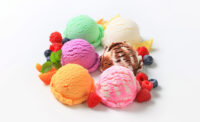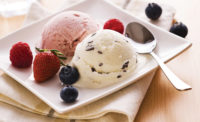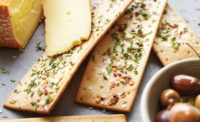These days, terms such as keto, paleo, high-protein, plant-based, vegan — even “pegan” (paleo-plus-vegan) — describe not just diets but entire lifestyles. So you’d think that a decadent space such as the frozen dessert aisle would be a lonely patch. With everyone going free from everything, how much room could there be in the cart for ice cream and ice cream cake?
Apparently, plenty. As Christine Addington, senior dairy technical service specialist for Cargill, Minneapolis, put it, “Americans still love their frozen dairy treats.”
However, the frozen dairy treats they’re consuming aren’t sitting still. Like today’s consumers, they’re continually evolving.
“Consumers demand more from the products they purchase, even in indulgent categories like frozen desserts,” Addington said. “Better-for-you options are gaining shelf space, whether they have more protein, cleaner ingredients, less sugar or extra fiber.”
Mindful, not meh
“The trends shaping the frozen-dessert category continue to echo the broader trends influencing the changing food landscape,” said Jayme Caruso, chief commercial officer for Epogee, Indianapolis. “While consumers still spend on indulgent products, evidence shows they’re making more mindful choices when it comes to indulgence, and this is no different in the frozen-dessert category.
But “mindful” had better not mean “meh.”
“Even though consumers want healthier alternatives in frozen desserts, they’re increasingly unwilling to sacrifice flavor, texture or satiety,” Caruso continued. “Recent decades [were] littered with well-intentioned new products that fell short due to consumers’ insistence upon a great sensory experience.”
Kami R. Smith, director of culinary showcasing for Pecan Deluxe, Dallas, agreed.
“Frozen dessert trends are a moving target,” she said. “But when people dive into their favorite ice creams and desserts, they expect that the ice cream be scoopable, the inclusions recognizable and the overall flavor exactly as imagined.”
Serious depression
So imagine what happens when you start to cut sugar, as many dessert developers are. Sugar plays critical roles in frozen dairy, only one of which is providing sweetness. Sugar influences texture and melt rate, manages formulation water, contributes bulk and body — and perhaps most crucially, depresses an ice cream’s freezing point.
The lower that freezing point, the softer and more scoopable an ice cream’s texture. Dissolved solids — sugar being the principal one — depress that freezing point in direct proportion to their presence in the mix: the more solids, the lower the point at which the ice cream freezes.
“This is why we can still scoop ice cream directly from the freezer,” explained Andy Estal, director of the Beneo Technology Center and customer technical service, Americas region, Beneo Inc., Morris Plains, N.J.
The flip side is that once the dissolved-solids balance tips downward with sugar reduction, an ice cream’s freezing point risks rising so much that its texture becomes icy from the freezer.
“So to make a successful reduced-sugar ice cream,” Estal said, “we need to replace the sugar with an ingredient — or system of ingredients — that restores the dissolved-solids level to preserve the freezing-point depression.”
Thom King, CEO and president of Icon Foods, Portland, Ore., spends considerable time helping dairy-dessert customers do just that, and he said he’s had great success with “a combination of bulking and high-intensity sweeteners.”
His blueprint for a replacement system starts with the sugar alcohol erythritol, which contributes neither added sugars nor off-tastes. Next comes allulose, another sweetener that contributes mouthfeel, sugar-like sweetness and good overrun, but not added sugars.
“Lastly,” King said, “the addition of monk fruit and stevia to the system increases the overall sweetness without adding calories or carbs, and has the added benefit of mutually masking off-notes. The combination is the powerhouse of clean-label sugar reduction in frozen desserts.”
For his part, Estal suggested using isomalt to replace sugar while also maintaining freezing-point depression, mouthfeel, creaminess and scoopability. And because isomalt’s sweetness is 20% that of sugar, he added, no other sweetness correction is required when using it to make sugar replacements of up to approximately 25% in ice cream.
His company’s highly soluble inulin, OraftiHSI, also partially replaces sugar. At sugar-replacement levels of up to 25% to 30% weight-by-weight, Estal said, “it becomes a dissolved solid, exactly replacing sugar’s functionality and avoiding any changes in freezing-point depression.”
Other ingredients essential to successful frozen-dairy sugar reduction include maltodextrin, which helps restore bulk and replace sugar’s solids, and stabilizers such as locust bean gum and carrageenan, which give viscosity and manage water.
“Over time during frozen storage, small ice crystals naturally migrate together to form larger ice crystals,” Addington explained. “This causes ice cream to be coarse, icy and unpleasant to eat. Stabilizers control water to help keep the small crystals isolated and prevent their growing larger.”
Planting roots in the frozen-dessert aisle
Perhaps as inescapable in frozen desserts as sugar reduction are plant-based formulations.
“In the past few years you can see the investment retailers have made in expanding store layouts to include more frozen space for the fast-growing dairy alternative market,” said Sarah Diedrich, customer marketing manager for Synergy Flavors, Wauconda, Ill.
In fact, SPINS, Chicago, reported that sales of plant-based ice creams and frozen novelties grew 66.7% from April 2017 through April 2019.
But Diedrich said her company’s primary research shows most plant-based consumers also enjoy real dairy products. So plant-based patrons “know what full-fat dairy indulgence tastes like,” she continued, “and are less forgiving of foods that lack premium taste.”
Creating that premium taste is no easy feat.
“When plant-protein levels increase, there’s a tendency for the frozen dessert to acquire a sandy, gritty mouthfeel,” Addington pointed out.
Drop sugar levels and the challenges mount.
“Plant proteins create textural differences impacting hardness and melting properties,” Addington said, “and these are attributes we’d typically manage with sugar.”
But as plant-based proteins and adjunct ingredients have improved, the minefield for formulators has begun to clear. Rick Ray, director of food technology for Axiom Foods, Los Angeles, noted that alternatives such as rice, pea and oat are becoming more functional and widely available, and there are more innovations to come.
Jon Vander Woude, vice president of marketing for Denali Ingredients, New Berlin, Wis., voiced similar optimism.
“As plant-based foods and beverages continue to advance, we’ve developed many nondairy frozen-dessert bases and ingredients, from coconut to almond and, most recently, oat — all of which behave differently in application,” he said.
Follow the flexitarians
But rather than going all-in on plant-based formulation, some experts suggest following flexitarians’ lead and capitalizing on the best of both worlds.
“Base product innovations on great-tasting and functional underutilized dairy ingredients such as skim milk, whey and buttermilk, coupled with plant-based fats such as palm, soy and coconut, which are three to five times less costly than butterfat, ” Aaron Jordi, account manager, frozen dessert for Agropur, Saint-Hubert, Longueuil, Canada, suggested.
Brands should also consider adding nut butters or oats to dairy dessert bases to create products featuring plant-based flavors and dairy’s nutrition and functionality, added Caleb Wagner, food technologist, frozen dessert, at Agropur.
“Plant-based fats allow further customization of texture over what milkfat can achieve,” Wagner said. “For example, blending in plant fats can enhance creaminess and overrun-holding capabilities while eliminating the need for some emulsifiers and reducing product costs overall.”
American Almond, a division of Barry Callebaut, Chicago, produces textured nut-butter variegates made with roasted and toasted nuts that “can make a frozen-dessert base that rivals real dairy ice cream,” claimed John Pimpo, market segment manager for ice cream at Barry Callebaut.
But the variegates are also irresistible inclusions in any frozen dessert, nondairy or dairy.
“They provide a unique textural experience to real dairy ice cream, frozen desserts and novelties,” Pimpo said.
More than a feeling
Such unique textural experiences increasingly drive consumers’ frozen-dessert choices.
“Texture is at the forefront of frozen-dessert trends,” observed Tara Gonzales, marketing manager at Pecan Deluxe.
She suggested blending multiple textures, such as crunchy and creamy, into a formulation, or working with “creative mix-ins that provide an experience — perhaps a fizz, pop or change of color. Foods, including frozen desserts, are similar to most things in life in that the more senses involved, the longer-lasting the impression.”
Pimpo and his research and development (R&D) team put that principle into practice with the company’s brown-butter bourbon truffle inclusions, which he described as “brown-butter caramel infused with real Kentucky bourbon, all surrounded by a milk chocolaty coating.”
Seeing is believing
Pops of color are growing ever more important, too, as more of our lives, including our dessert choices, play out visually on social media.
“Color and texture combined engage the younger generation, which is hungry for interactivity and experiences to document in their everyday,” Gonzales noted.
Meghan Fox, marketing specialist for Sensient Colors, St. Louis, agreed.
“There’s no denying social media’s impact on consumers’ lives today, and the extremely visual Instagrammable food trend continues to surge,” she said.
Her company offers a range of colorful inclusions, including flecks “to create a funfetti appearance,” and pearlescent pigments that add “shimmer for a glittery effects,” she said.
For Halloween, Olam Cocoa’s North American product development team developed a black waffle cone with a black dairy-free coconut-based ice cream.
“The visuals were on par with the flavor,” said Wouter Stomph, the team’s manager. “Adding a red sauce to it gave it another ‘wow’ factor.”
Stomph noted that black ice cream typically gets its color using charcoal, but that usage has come under scrutiny. The use of cocoa powder instead fits in with clean-label trends and results in a better taste.
Diedrich pointed out that her company’s certified-organic water-based hibiscus extract “easily translates into frozen dessert formulations to deliver a light, fruity floral profile with an Instagram-worthy appearance, from vibrant pink in popsicles and magenta in sauces to soft purple in dairy-based desserts.”
And Jill Houk, R&D chef at Olam Spices, Singapore, says turmeric can give dairy desserts a pretty saturated goldenrod color. Her company developed an ice cream concept based on Indian golden milk comprising a standard ice cream base with turmeric, cinnamon, cardamom, ginger, black pepper and vanilla.
“It’s delicious, eye-catching and filled with healthy spices,” Houk said. “They’re typically used at a low inclusion rate, too — less than 2% — so they don’t affect texture or processing.”
All in good taste
Botanically based ingredients actually are gaining traction across many categories, including frozen desserts.
“A popular ice cream maker has launched a floral collection of ice creams in Europe with distinctive flavors like elderflower and cherry blossom, and you can already find flavors like lavender and jasmine at scoop shops in the U.S.,” noted Keera Perumbala, marketing manager for Sensient Flavors, Hoffman Estates, Ill.
This makes sense to Philip Caputo, marketing and consumer insights manager for Virginia Dare, New York, who predicts that trends such as holistic health and traditional medicine will drive functional ingredient use, flavor inspiration and product formulation from now into the next year. As a result, functional flavors that characterize or are inspired by botanicals, spices and healing herbs “will shape the frozen-dessert category,” he said.




